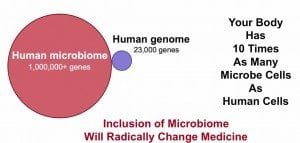
Gut Microbiome and you...
Healing leaky gut requires understanding a little something about your gut microbiome and who you really are. In fact, it may surprise you to learn that you are actually more "them" than you are "you". Your body is home to about 100 trillion bacteria and other microbes, collectively known as your microbiome. Since the invention of the microscope back in the 1600's, naturalists have been aware of our hitchhiking microbes but it wasn’t until the past five years that we're getting to know them better.
New Research
For decades, bacteria have been given a bad rap. They are the cause of infections and disease. They are something to be scrubbed away, disinfected and avoided. But now researchers have taken a detailed look at sets of tiny organisms that may play an even stronger role in health and disease: the 100 trillion friendly bacteria that live in or on the human body.
No one really knew that they are essential for human life, needed to digest food, to synthesize certain vitamins and to form a barricade against disease-causing bacteria. But what do they look like in healthy people, and how much do they vary from person to person?
The Human Microbiome
In a new five-year federal endeavor, the Human Microbiome Project, which has been compared to the Human Genome Project, 200 scientists at 80 institutions sequenced the genetic material of bacteria taken from nearly 250 healthy people.
They discovered more strains than they had ever imagined — as many as a thousand bacterial strains on each person. And each person’s collection of microbes, the microbiome, was different from the next person’s. To the scientists’ surprise, they also found genetic signatures of disease-causing bacteria lurking in everyone’s microbiome. But instead of making people ill, or even infectious, these disease-causing microbes simply live peacefully among their neighbors.
The results, published last week in Nature and three PLoS journals, are expected to change the research landscape and impact western medicine in big ways. 
Karl Zimmer, NY Times reports:
Prior to this study the bacteria in the microbiome were thought to be just “passive riders.” They were barely studied, microbiologists explained, because it was hard to know much about them. They are so adapted to living on body surfaces and in body cavities, surrounded by other bacteria, that many could not be cultured and grown in the lab. Even if they did survive in the lab, they often behaved differently in this alien environment. It was only with the advent of relatively cheap and fast gene sequencing methods that investigators were able to ask what bacteria were present.
In recent years, as investigators began to probe the microbiome in small studies, they began to appreciate its importance. Not only do the bacteria help keep people healthy, but they also are thought to help explain why individuals react differently to various drugs and why some are susceptible to certain infectious diseases while others are impervious. When they go awry they are thought to contribute to chronic diseases and conditions like irritable bowel syndrome, asthma, even, possibly, obesity.
Humans, said Dr. David Relman, a Stanford microbiologist, are like coral, “an assemblage of life-forms living together.”
Dr. Barnett Kramer, director of the division of cancer prevention at the National Cancer Institute, who was not involved with the research project, had another image. Humans, he said, in some sense are made mostly of microbes. From the standpoint of our microbiome, he added, “we may just serve as packaging.”
A Microbiome Is Born
The microbiome starts to grow at birth, said Lita Proctor, program director for the Human Microbiome Project. As babies pass through the birth canal, they pick up bacteria from the mother’s vaginal microbiome.
“Babies are microbe magnets,” Dr. Proctor said. Over the next two to three years, the babies’ microbiomes mature and grow while their immune systems develop in concert, learning not to attack the bacteria, recognizing them as friendly.
Babies born by Caesarean section, Dr. Proctor added, start out with different microbiomes, but it is not yet known whether their microbiomes remain different after they mature. In adults, the body carries two to five pounds of bacteria, even though these cells are minuscule — one-tenth to one-hundredth the size of a human cell, the gut in particular, is stuffed with them.
“The gut is not jam-packed with food; it is jam-packed with microbes,” Dr. Proctor said. “Half of your stool is not leftover food. It is microbial biomass.” But bacteria multiply so quickly that they replenish their numbers as fast as they are excreted.
Immunity Helpers
The bacteria also help the immune system, Dr. Huttenhower said. The best example is in the vagina, where they secrete chemicals that can kill other bacteria and make the environment slightly acidic, which is unappealing to other microbes.
Including the microbiome as part of an individual is, some researchers say, a new way to look at human beings.
But, Dr. Relman said, “we are scratching at the surface now.”
It is, he said, “humbling.”
Excerpts from NY Times article by Karl Zimmer, "Tending the Bodies Microbial Garden"


